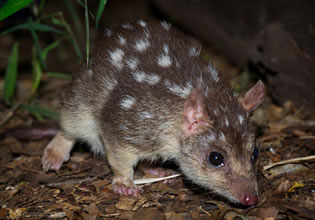The Endangered Northern Quoll....
 The Northern Quoll, Dasyurus hallucatus are classified as Endangered
by the Commonwealth Environment and Biodiversity Conservation Act
1999 due to the massive population declines that they have suffered
over the past 200 years.
The Northern Quoll, Dasyurus hallucatus are classified as Endangered
by the Commonwealth Environment and Biodiversity Conservation Act
1999 due to the massive population declines that they have suffered
over the past 200 years.
In Queensland, the northern Atherton Tablelands, including the upper
Walsh River area, are one of only a handful of sites at which this
endangered species is still common.
The reason for the endangered status of quolls is due to the devastating
impacts by Cane Toads, and because they only live for one year,
it means that a single failed breeding season due to disturbance
or degradation of habitat (such as mining) can send a local population
extinct.
Quoll populations are very susceptible to local extinction due to
habitat degradation, or increased accidental or deliberate killing.
This is in large part due to their opportunistic behaviour which
brings them into contact with dangerous human environments (e.g.
roads, chook pens etc).
Scott Burnett, a university professor, has studied the
Northern Quoll for many years and has conducted studies within the
proposed mining lease area. He is confident that a widespread search
would find quolls throughout the lease area and that the proposed
mine development could be a disaster for the local quolls populations,
depending on the intensity of the mining activity.
During the late dry breeding season access to standing water within
the Toy Creek (and other channels) is absolutely critical for successful
rearing of young quolls. Loss of this water or contamination would
be potentially devastating. During the breeding season, in particular,
females drink regularly and will travel considerable distances if
they have to (perhaps up to 0.5 – 1km) to access standing
water.
Finally, any removal or disturbance to vegetation including ground
cover and tree cover, or of rocks and boulders (used for foraging
and denning), is likely to have a considerable impact on the quolls
residing within the lease area. An open cut mine on the site has
the potential to gut the quoll population. Quolls are territorial,
therefore displacement = death, as all territories are likely already
occupied, so displaced animals have nowhere to live.
However it is difficult to predict what this would mean to the wider
quoll meta-population without detailed studies of dispersal, population
size and extent and genetic ecology of the quolls in this area.
To be continued....
|


 The Northern Quoll, Dasyurus hallucatus are classified as Endangered
by the Commonwealth Environment and Biodiversity Conservation Act
1999 due to the massive population declines that they have suffered
over the past 200 years.
The Northern Quoll, Dasyurus hallucatus are classified as Endangered
by the Commonwealth Environment and Biodiversity Conservation Act
1999 due to the massive population declines that they have suffered
over the past 200 years.